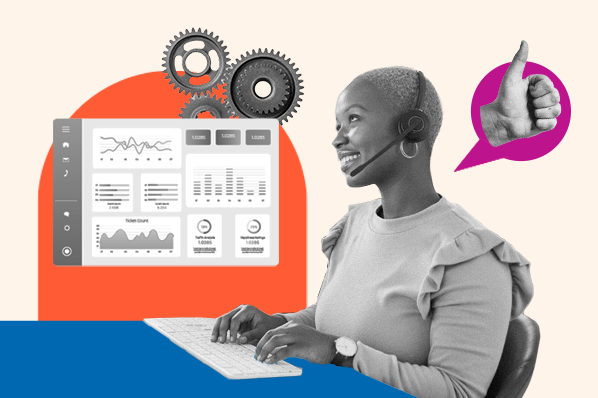When a customer has a service request, they have an idea of how they should be treated and how quickly they'll receive a response. And, customer service expectations are only becoming more demanding as time goes on. In fact, our latest study shows that 88% of service professionals believe that customers have higher expectations than they did in the past.

Meeting these expectations builds trust with your customers. Missing them creates more frustration. Priority support can help your team close the gap between how customers feel they should be treated and the level of support they actually receive.
In this post, we'll go over what priority support is and how you can implement it into your customer service team.
Priority Support
When you started your customer service team, it's likely they worked with the first question in the queue then moved on to the next one. But, as your volume increases, the "first-in, first-out" system means that customers with urgent needs get stuck at the back of the line.
Instead, your team's response time should be dictated by the level of support your customer has and the urgency of the issue they're experiencing. Priority support highlights these customers and helps your team resolve their issues in a timely manner.
Not sure how to create this process for prioritization? Read on for a step-by-step guide on how to rank customer service issues using priority support.
How to Create a Priority Support System
1. Segment your customer base.
Before you can establish a priority support system, it's important to have a good understanding of your buyer personas and align them with your pricing model. If you're a SaaS business, you can segment your customer base by how much they pay for their subscription. Or, if you offer one-time purchases, you can break up customers based on how much they have paid.
For example, if someone pays $49 over the course of their customer journey, you would group them separately from customers who pay $450. The same goes for subscription models: customers paying for single user subscriptions are grouped separately from people who are paying for enterprise.
2. Offer support as a product.
As your customer base grows, you should also consider offering an option to purchase support as a product. For example, HubSpot offers services like personalized coaching, on-demand support, and onboarding consulting. By breaking down our customer base into segments, we can identify customers who can benefit from these services the most.
3. Create support ticket priority levels.
Not all support issues are created equal. Instead, the customer's needs and relationship with your brand should dictate the priority of a support request. This is where it helps to create support ticket priority levels to organize the urgency of incoming service cases.
Support ticket priority levels are set guidelines that your team members can use to categorize service issues. This includes any problem ranging from product issues to pricing inquiries. Below are a few examples you should consider.
- Low: These questions are from people who aren't active customers or leads. This includes sponsorship requests and general customer feedback that doesn't require an immediate response.
- Normal: These are questions or issues that aren't blocking customers from using the product, but they do require a quick response.
- High: These issues prevent using the product or service effectively. They require an immediate response.
- Urgent: These are issues that either completely blocks the use of the product or are coming from upset customers who need their case escalated. These problems should always be your top priority.
Remember, every customer question is important, but not everything is urgent. By clearly setting out priorities for incoming questions, agents can decide what needs their attention first. Alternatively, this matrix can become the basis for automating your customer service workflow.
4. Integrate automated tagging into your help desk.
Once you've decided on your support priority levels, you can streamline the categorization process using automated tagging. Automated tagging automatically labels incoming service requests, so your team can quickly spot and respond to urgent issues. This is a feature that's included in most help desk software and can significantly improve the customer's experience.
5. Use Service-Level Agreements (SLAs).
Depending on your ticket volume, your team might not be able to answer all of the highest-priority cases before moving onto the lower-priority ones. This creates a tough choice for management because at some point you'll need to answer those lower-priority tickets. This is where Service-Level Agreements can be used to ensure lower-priority tickets aren't backlogged in your queue forever.
Tickets that have been in your queue for longer should move up the priority ladder. For example, "Low" priority tickets might have a First Reply Time SLA of 3 days. As that deadline looms closer, the priority should increase to "Normal" priority. In comparison, "Urgent" tickets should have a First Reply Time of one hour. Using SLA's will create consistency in your response time and ensure every customer is accounted for.
6. Consistently re-evaluate your process.
As you tweak your system for the needs of your customers and your support team, you'll start to find yourself re-evaluating. This is good! Nothing in business remains the same forever, and the same should be said about your support strategy.
Pay attention to customer satisfaction measures like CSAT and NPS®, and make sure you're tracking the response time across different priority groups. As customers provide feedback, make changes to prioritize certain issues that are higher or lower on your scale.
For example, you can track some of the more frequent technical issues that come through your support segments. After you identify some common glitches or bugs, send your findings to your engineering and product development teams to correct. This process will fix bugs faster and reduce incoming requests for your support team.
If you're looking for more helpful service tools, read through our guide for customer support tools and resources.
Net Promoter, Net Promoter System, Net Promoter Score, NPS and the NPS-related emoticons are registered trademarks of Bain & Company, Inc., Fred Reichheld and Satmetrix Systems, Inc.
![Access Now: Customer Support Strategy Template [Free Tool]](https://no-cache.hubspot.com/cta/default/53/7dff7d77-3a4c-40ea-a4c8-376b827a83ab.png)










![Why Gen Z Demands Exceptional Customer Support [New Data]](https://www.hubspot.com/hubfs/Featured%20Image%20Template%20Backgrounds_AC%20Copy.png)